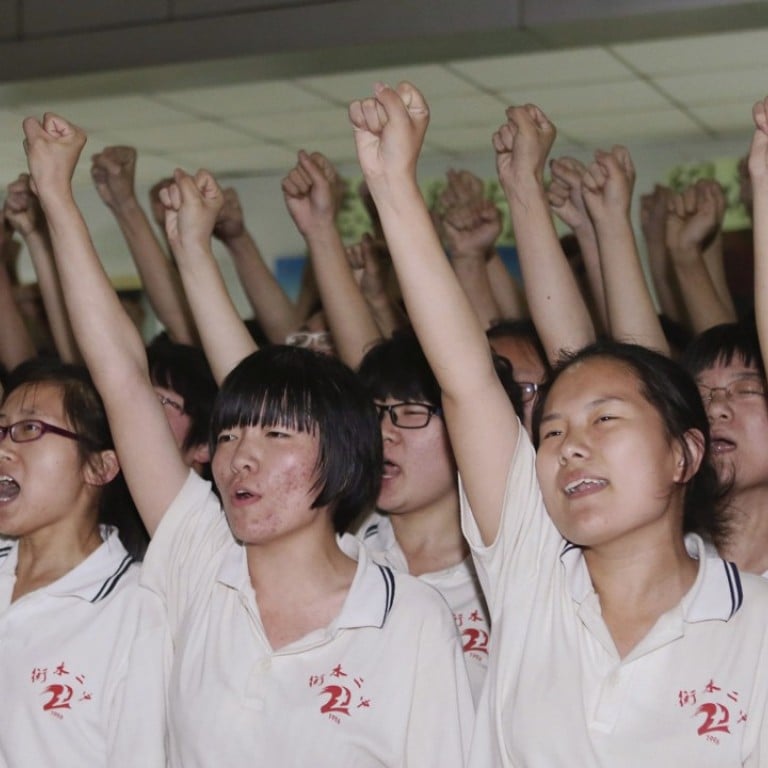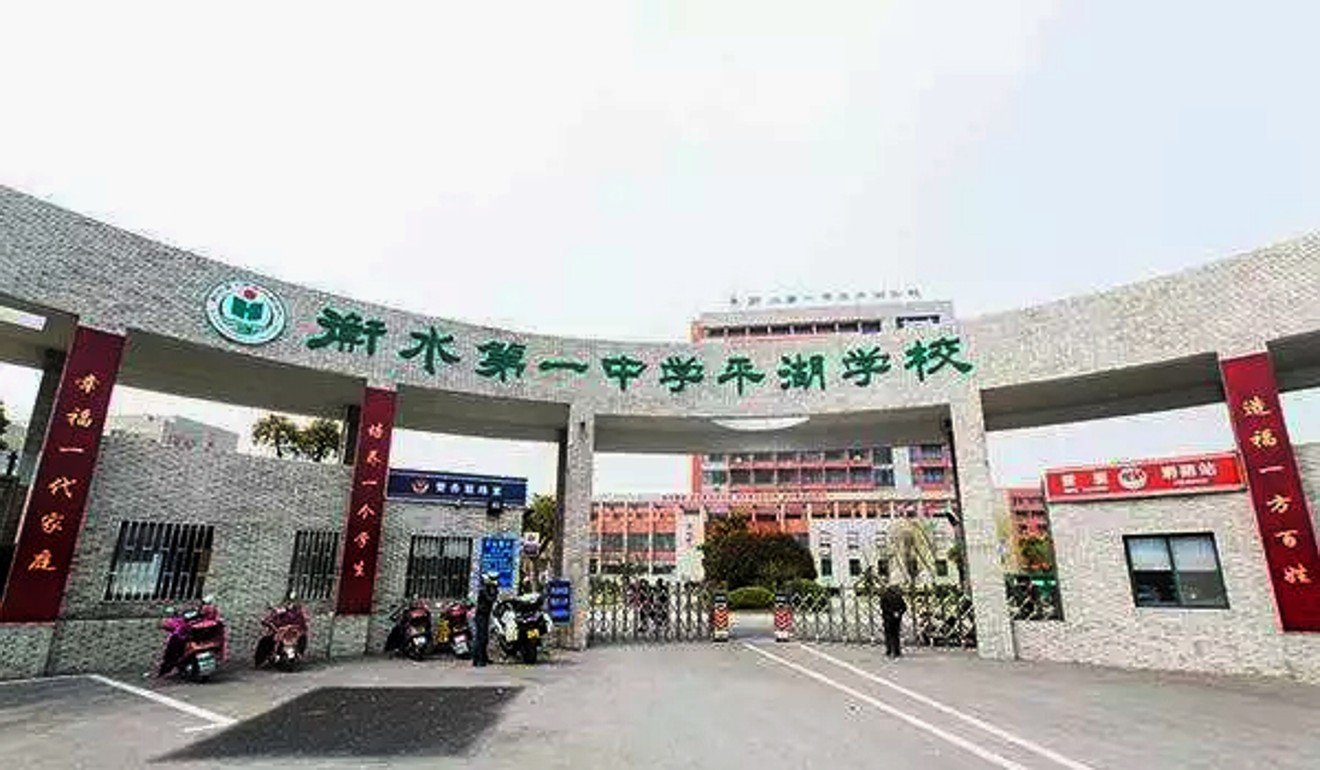
China’s top cram school: a saviour to the poor but rejected by the rich
Hengshui High School is a lifeline for pupils from impoverished regions, but its new branch in wealthy Zhejiang has been criticised for its controversial teaching methods
How far would you go to secure a place in one of China’s top universities? Pupils from one of the country’s most notorious cram schools spend 12 hours a day studying, attending up to 13 classes and taking just 15 minutes out for each meal. They’re not allowed to interact too closely with peers of the opposite sex, banned from snacking and are punished if their attention wanders during lessons.
The pupils, aged 15 to 18, attend Hengshui High School, based in Hebei province, for one reason, to do well enough in the gaokao university entrance examination to be accepted into one of China’s most prestigious tertiary institutions.
The military-style schooling has been proven to work. Last year, 139 pupils from the school made it into Peking University and Tsinghua University, China’s two top universities. The number was the highest among all Chinese high schools.
Over the years, Hengshui High School, which has been dubbed China’s “gaokao factory”, has set up 18 branches in underdeveloped areas across Hebei, Henan, Anhui, Sichuan and Yunnan provinces. They offer their controversial schooling technique as the best way to help lift young locals out of poverty.
WATCH: Life in Hengshui High School
Now, the school has made its first foray into a rich province, Zhejiang, hoping to find the same popularity and success it has achieved elsewhere. The school’s newest branch opened in Pinghu in March, offering pupils 500,000 yuan (US$72,500) if they are accepted into Peking University or Tsinghua.
The branch, which opened with the blessings of the local government, shares the main school’s management and teaching staff. The Pinghu authorities had invited Hengshui High School to set up shop in the city, which lies just 100km south of Shanghai, China News Service reported, in a move was aimed at attracting more talent and investment to the region.
But though the new school, which is fully funded by a Guangzhou property development firm, has found favour among local families – filling its first batch of 90 vacancies fairly quickly – it has received strong criticism from education officials and experts who do not condone its contentious methods.
“Hengshui High School’s teaching model is so test-oriented that in its eyes, there are only scores and no humans,” Fang Hongfeng, director of the Zhejiang provincial education department’s basic education office, told local news portal Cztv.com. “We Zhejiang people have no need for it.”
Professor Fang Zhanhua, from Zhejiang University’s school of education, agreed. “The school’s methods will harm our teenagers and stunt the development of their personality and creativity,” he told the South China Morning Post. “The Hengshui model is definitely not aligned with the direction of our province’s education reforms.”
The education experts’ criticism of the cram school has been so intense that it has caught the attention of the Ministry of Education, which this month ordered the provincial authorities to “launch a special assessment” of Hengshui’s new branch.
WATCH: Pupils at Hengshui High School
Zhejiang is among a handful of regions revamping their high school curriculums to allow pupils a wider range of course options and to select subjects based on their own interests. The reforms are part of the national education authorities’ efforts to shift schools’ exams-oriented focus towards a more nurturing, all-rounded and quality-based system.
The flourishing business of “gaokao factories” such as Hengshui High School, which focus solely on achieving examination excellence, is therefore a slap in the face for the authorities.
The Hengshui school, which has three grade levels, admits 5,400 pupils at each grade. A teacher at the school told the Guangzhou-based Southern Weekly newspaper in 2013 that pupils follow strict schedules that stipulate exactly what they are to do in each time slot.
A booming alarm rouses the pupils at 5.30am every day, and they are greeted by a large slogan displayed prominently on the campus reminding them that the competition started the moment they awoke. Studying takes up half their day, and the teenagers are bound by stifling school rules, including being banned from owning cell phones.
Pupils caught snacking, daydreaming or interacting too often with the opposite sex get marks deducted. Entering into a boyfriend-girlfriend relationship with a schoolmate risks expulsion. Shops on campus sell only daily necessities and study-related products; no food or snacks.
The rigid discipline and the endless practice papers they do every day train them to perform exceptionally well in the gaokao, which rewards the ability to regurgitate large volumes of information more than strong critical thinking and analytical skills.

The Hengshui model had been embraced in China’s poorer regions because “the gaokao is still the only way for children from impoverished households to change their fate and to ascend the class ladder”, Professor Fan Xianzuo, from Central China Normal University’s school of education in Wuhan, Hubei, told the Post.
Graduating from one of China’s top universities guarantees a bright future, and often, status, wealth and even power. “Schools like Hengshui have been criticised for years for using unreasonable teaching methods, but there are reasons they exist,” Fan said.
Xia Huixian, dean of Shanghai Normal University’s school of education, said parents from the poor provinces who admired the Hengshui model failed to realise that the school’s success lay in its strategy of assembling good pupils in the first place, rather than the fact that its teaching methods were good.
The situation was different in rich Zhejiang province, however. “The Hengshui school thinks it can easily open branches in Zhejiang like it has done in the poor provinces. It’s an insult to Zhejiang people’s intelligence,” he said.
Calls to Hengshui High School and its Pinghu branch went unanswered.


